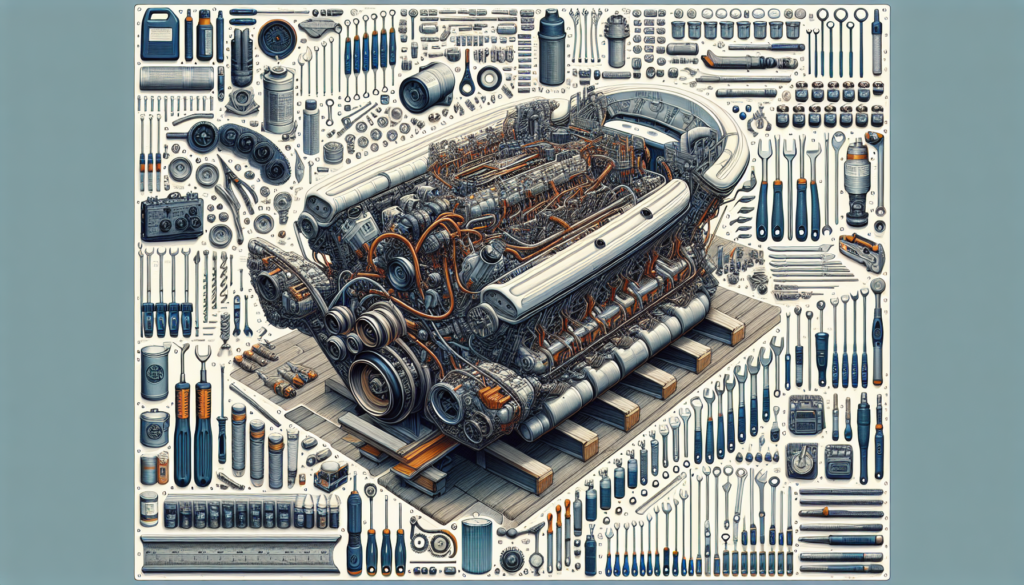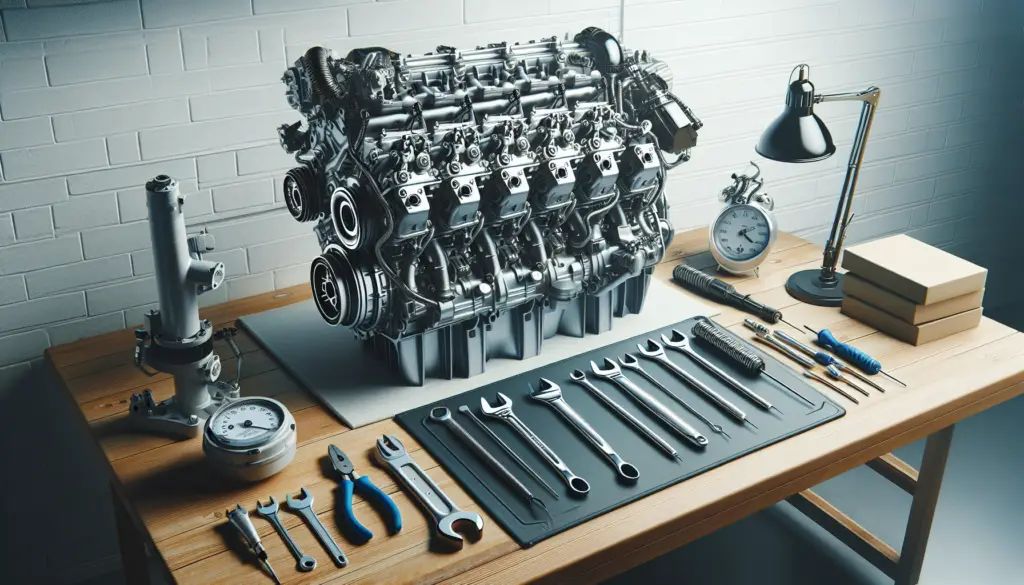Going on a big boat trip? It’s essential to ensure your boat engine is operating at premium capabilities to avoid any potential inconveniences. “The Ultimate Checklist For Servicing Your Boat Engine Before A Big Trip” is designed to help you rigorously evaluate and service your boat engine. This article elucidates a comprehensive checklist that you can use to minimize the risk of engine failure and maximize your enjoyment on water. From the basics of checking fuel filters to more complex tasks like inspecting drive belts, this guide has got you covered! Enjoy a stress-free trip by taking the time now to prepare your boat engine properly.

Understanding the Importance of Regular Engine Maintenance
People often say prevention is better than cure. The same philosophy applies when it comes to your boat engine. If you love sailing and want to keep your boat running smoothly, pay heed to the importance of regular engine maintenance.
Importance of regular checks on the boat engine
Regular checks on the boat’s engine not only help in keeping the engine performance high but also extend the engine’s lifespan. The marine environment is harsh. Salt water, humidity, heat, and extended periods of non-use (which are quite common with seasonal boaters) can lead to the rapid deterioration of boat engines. Regular maintenance will save you from any unplanned breakdowns and costly repairs down the line.
Potential risks and issues arising from neglecting maintenance
Neglecting maintenance can lead to a host of issues such as overheating due to poor coolant system performance, loss of power because of a dirty fuel system, or even complete engine failure due to degraded oil. These problems are not only hazardous to your boat’s health but they also pose a risk to your safety while sailing.
Assessing Your Boat Engine’s Overall Condition
It’s essential to establish the health of your boat’s engine. Regular assessments will help you spot potential failures early on and maintain optimum engine performance.
Checking for visible signs of wear and tear
Inspect the engine regularly for visible signs of wear, rust, or corrosion. Check the seals for leaks, observe the hoses and belts for cracks or fraying, and keep an eye on changes in oil or coolant levels.
Evaluating engine performance and any change in behavior
You need to evaluate your engine’s performance by starting it and listening for unusual sounds. Knocking, rattling, or coughing could be indicators of problems. Changes in how your engine starts, sounds while running, or generates power can indicate issues that need to be addressed.
Running a diagnostics test if available
If your boat’s engine has a diagnostics system, use it to evaluate engine health. Diagnostic tools can provide important information about engine temperature, fuel efficiency, and battery strength, and can even flag potential mechanical issues.
Checking and Replacing Engine Oil
Engine oil plays a pivotal role in your boat’s health. It lubricates various engine components and reduces friction.
Determining when to change engine oil
It’s vitally important to know when to change your boat engine oil. Most manufacturers recommend changing engine oil every 100 hours of operation or at least once a year. However, this can vary depending on the engine type. Always refer to your owner’s manual for the specifics.
Selecting the right oil for your boat’s engine
Choosing the right oil for your boat’s engine is crucial. Not all oils are created equal, and using the wrong kind could risk damage or inferior performance. Your boat’s engine might require conventional, synthetic, or semi-synthetic oil. The viscosity rating required is typically written in your engine user manual.
Step-by-step guide to changing the engine oil
Changing oil is a simple procedure that most boat owners can perform. You drain the old oil, replace the oil filter, then replenish with new oil. But remember, it’s important to follow your engine manufacturer’s specifications and perform oil changes in an environmentally responsible way.
Checking and Replacing Fuel Filters
A fuel filter plays an important role in keeping your boat’s engine clean. It filters impurities in the gas, such as dust, rust particles, and water droplets, which can damage the engine.
Understanding the role of fuel filters
A fuel filter prevents harmful detritus from entering the engine. It helps preserve the engine’s health and contributes to a consistent, reliable performance.
Identifying signs of a clogged or worn out filter
Signs of a clogged filter include a loss of engine power, especially at high speeds, or an engine that won’t start. If you experience any of these symptoms, it’s time to inspect your fuel filter or consider a replacement.
How to change a fuel filter
Changing a fuel filter is a straightforward job, typically involving the replacement of a cartridge. Ensuring that the replacement filter matches your engine’s specifications is crucial. Remember to prime or fill the fuel filter with clean fuel before installation and always dispose of used filters responsibly.

Inspecting and Cleaning the Fuel Tank
The fuel tank is often overlooked during maintenance but it’s just as important as other parts of your boat engine system.
Criteria for a clean fuel tank
A clean fuel tank should be free from dirt, water, and other contaminants. These can lead to engine performance issues or even engine failures if they find their way into the fuel system.
Recommended procedures for cleaning the fuel tank
To clean your fuel tank, remove any fuel, then use specially designed cleaning solvents or soaps that break down residues without damaging the tank. After cleaning, thoroughly dry the tank before refueling.
Preventing contamination and sediment build-up in the tank
Avoiding contamination and sediment build-up in your fuel tank requires some preventive measures. Always use clean, fresh fuel, and ensure your fuel cap seals properly to prevent water ingress.
Checking and Maintaining Cooling Systems
Your boat’s cooling system is integral to its operation and is responsible for preventing overheating.
Role of the cooling system in engine performance
Without a functional cooling system, your boat’s engine could overheat, leading to an array of engine malfunctions, and possibly even a complete engine failure.
Signs of a failing cooling system
Symptoms of a failing cooling system vary. However, common signs include frequent engine overheating, coolant leaks, and steam coming from the engine. Regularly checking the coolant level and inspecting the system for leaks is critical to maintaining a healthy cooling system.
Steps to check and maintain the cooling system
Checking and maintaining the cooling system involves first visually inspecting the coolant level and then checking the radiator cap, hoses, and engine for leaks. Regular coolant flushes according to your engine manufacturer’s guidelines will also aid in keeping the cooling system healthy.

Inspecting and Replacing Spark Plugs
Spark plugs provide the spark required to ignite the fuel-air mixture in your engine’s cylinders.
Interpreting conditions of used spark plugs
A used spark plug can reveal a lot about your engine’s health. If your spark plugs are covered in oil or soot, it means your engine might not be burning fuel efficiently. On the other hand, if they are white or blistered, your engine may be running too hot.
Choosing the right spark plugs for replacement
Choosing the right spark plugs for your boat’s engine can make a significant difference in engine performance. Check your owner’s manual for the correct type and gap size.
Replacing spark plugs in a boat engine
Spark plug replacement is pretty straightforward and involves removing and replacing each spark plug one at a time. Always make sure the engine is off before you start, prevent any debris from entering the open spark plug hole, and never over-tighten the new spark plug.
Checking and Maintaining Belts and Hoses
The belts and hoses in your boat engine are often subjected to high temperatures and pressures, which can lead to wear and tear over time.
Inspecting for cracks, leaks, or looseness
Inspect all belts and hoses for signs of ageing, such as cracks, hardening, or brittleness. Check hoses for any leaks. Also, observe the tension of the belts – if they feel loose or are fraying, they might need replacement.
Understanding the right tension for belts and hoses
Understanding the right tension for belts and hoses is crucial for optimal performance. If the tension is too low, the belt may slip, causing the engine to not operate accurately. If the tension is too high, it can lead to the premature wear of the engine’s components.
Replacing worn out belts and hoses
The process of replacing worn-out belts and hoses is a bit technical, and depending on your level of mechanical ability, you might prefer to leave this to a professional. Always ensure replacements match the specifications of your engine and are installed at the right tension.

Battery Maintenance
The battery is the lifeblood of your boat’s electrical system. Keeping it well-maintained ensures that your boat is always ready to start up and go.
Checking battery charge and health
Regularly check your battery charge, especially if the battery is undergoing frequent discharges. A multi-meter can be used to check voltage levels. If your battery is not holding a charge as it should, it might be time for a replacement.
Cleaning battery terminals to prevent corrosion
Corrosion can limit the efficiency of your battery. Regularly clean the terminals with a commercially available battery cleaning solution and a wire brush to keep them free of corrosion.
Choosing a replacement battery when necessary
If your battery isn’t holding a charge or has other irreversible issues, replacement is the only option. Choose a battery that matches your engine’s specifications, as well as your boating habits.
The Importance of Having a Skilled Mechanic
While it’s feasible to carry out many maintenance tasks yourself, there are instances when the knowledge and skills of a trained mechanic will be invaluable.
When to employ a mechanic for advanced issues
While you might feel comfortable changing the oil or replacing spark plugs, more advanced issues such as overheating or electrical problems often require the expertise of a skilled mechanic.
Finding a reliable mechanic in your area
Locating a reliable mechanic in your area can be as simple as asking for recommendations from other boaters or checking online review sites. Always look for mechanics who are certified by reputable marine institutes and who have experience working with your specific type of engine.
Understanding mechanic reviews and certifications
As with most professionals, not all mechanics are created equal. Understanding reviews and the importance of certifications can help ensure you find a mechanic who is well-equipped to keep your boat running smoothly. In conclusion, maintaining your boat engine involves regular checks, monitoring performance changes, changing oil and filters, keeping fuel tanks clean, checking cooling systems, replacing spark plugs, maintaining belts, hoses, batteries, and having a skilled mechanic on call. By conducting regular maintenance, you can enjoy safe and hassle-free boating for years to come.

